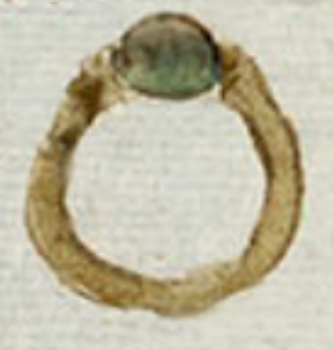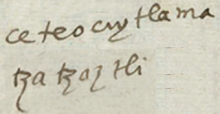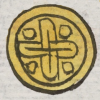teocuitlamatzatzaztli (CST43)
This is a painting of the simplex glyph for a gold finger ring (teocuitlamatzatzaztli). The color of the ring (matzatzaztli) is indeed gold in color and therefore probably made of yellow gold (teocuitlatl). The ring is shown in a bird's eye view with the precious green stone (chalchihuitl) at the top, and the viewer’s gaze could be looking through the hole in the ring. The companion text says that there was a need for the ring at the palace (tecpan). Perhaps it was destined for doña Catalina, the cihuapilli (noblewoman) and wife of the gobernador. Perhaps it was a perquisite of the ruling class to have this kind of jewelry. The cost was 13 pesos.
Stephanie Wood
For more on the Codex Sierra, see Kevin Terraciano’s study (2021), and especially pp. 126 and 159, for his Nahuatl transcription and English translation. Below are some glyphs in the collection that involve gold or precious greenstones, along with a portrait of the cihuapilli, doña Catalina of Texupan, who figures in the Codex Sierra.
Stephanie Wood
1550–1564
Jeff Haskett-Wood
anillos, jades, chalchihuites, manos, dedos, joyería

teocuitla(tl), precious metal, gold or silver (but here, gold), https://nahuatl.wired-humanities.org/content/teocuitlatl
matzatzaz(tli), a finger ring, https://nahuatl.wired-humanities.org/content/matzatzaztli
anillo de dedo
Stephanie Wood
Códice Sierra-Texupan, plate 43, page dated 1561. Origin: Santa Catalina Texupan, Mixteca Alta, State of Oaxaca. Kevin Terraciano has published an outstanding study of this manuscript (Codex Sierra, 2021), and in his book he refers to alphabetic and “pictorial” writing, not hieroglyphic writing. We are still counting some of the imagery from this source as hieroglyphic writing, but we are also including examples of “iconography” where the images verge on European style illustrations or scenes showing activities. We have this iconography category so that such images can be fruitfully compared with hieroglyphs. Hieroglyphic writing was evolving as a result of the influence of European illustrations, and even alphabetic writing impacted it.
https://bidilaf.buap.mx/objeto.xql?id=48281&busqueda=Texupan&action=search
The Biblioteca Digital Lafragua of the Biblioteca Histórica José María Lafragua in Puebla, Mexico, publishes this Códice Sierra-Texupan, 1550–1564 (62pp., 30.7 x 21.8 cm.), referring to it as being in the “Public Domain.” This image is published here under a Creative Commons license, asking that you cite the Biblioteca Digital Lafragua and this Visual Lexicon of Aztec Hieroglyphs.








